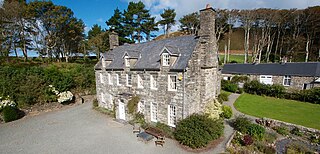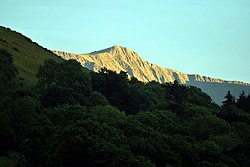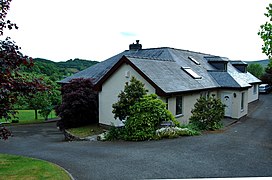
Snowdonia, or Eryri, is a mountainous region and national park in North Wales. It contains all 15 mountains in Wales over 3000 feet high, including the country's highest, Snowdon, which is 1,085 metres (3,560 ft) tall. These peaks are all part of the Snowdon, Glyderau, and Carneddau ranges in the north of the region. The shorter Moelwynion and Moel Hebog ranges lie immediately to the south.

Until 1974, Merionethshire or Merioneth was an administrative county in the north-west of Wales, later classed as one of the thirteen historic counties of Wales.

Barmouth is a seaside town and community in the county of Gwynedd, north-west Wales; it lies on the estuary of the Afon Mawddach and Cardigan Bay. Located in the historic county of Merionethshire, the Welsh form of the name is derived from aber (estuary) and the river's name, Mawddach. The English form of the name is a corruption of the earlier Welsh form Abermawdd. The community includes the villages of Llanaber, Cutiau and Caerdeon.

Dolgellau is a town and community in Gwynedd, north-west Wales, lying on the River Wnion, a tributary of the River Mawddach. It was the traditional county town of the historic county of Merionethshire until the county of Gwynedd was created in 1974. Dolgellau is the main base for climbers of Cadair Idris and Mynydd Moel which are visible from the town. Dolgellau is the second largest settlement in southern Gwynedd after Tywyn and includes the community of Penmaenpool.

The Afon Mawddach is a river in Gwynedd, Wales, which has its source in a wide area SH820300 north of Dduallt in Snowdonia. It is 28 miles (45 km) in length, and is much branched; many of the significant tributaries are of a similar size to the main river. The catchment area is bounded to the east by the Aran Fawddwy massif and to the west and north by the Harlech dome which forms a watershed just south of Llyn Trawsfynydd.

Cadair Idris or Cader Idris is a mountain in the Meirionnydd area of Gwynedd, Wales. It lies at the southern end of the Snowdonia National Park near the town of Dolgellau. The peak, which is one of the most popular in Wales for walkers and hikers, is composed largely of Ordovician igneous rocks, with classic glacial erosion features such as cwms, moraines, striated rocks, and roches moutonnées.

Cadwgan ap Bleddyn (1051–1111) was a prince of the Kingdom of Powys in north eastern Wales. He was the second son of Bleddyn ap Cynfyn who was king of both Kingdom of Powys and Gwynedd.

Arthog is a village, post town and community in the Meirionnydd area in Gwynedd, north Wales including the villages of Fairbourne and Friog. It is located on the A493, approximately 8 miles (13 km) west of Dolgellau, and had a population of 1,010 in 2001, increasing slightly to 1,031 at the 2011 census.
This is a list of Sheriffs of Merionethshire. The historic county of Merioneth was originally created in 1284. The administrative county of Merioneth was created from the historic county under the Local Government Act 1888.

Llanfendigaid Estate, located on the Cardigan Bay coast of southern Gwynedd, near Tywyn in north Wales is a mid-Georgian house that has belonged to the same family for over 600 years. Llanfendigaid is listed Grade II* by Cadw which is only given to houses of exceptional historic interest. The estate once encompassed over 16,000 acres (65 km2), is now reduced to 16 acres (0.065 km2) within the Snowdonia National Park.
Sir Hugh John Ellis-Nanney, 1st Baronet, was a Welsh landowner, magistrate and political candidate.
The Baronetcy of Ellis-Nanney of Gwynfryn and Cefndeuddwr was granted to Hugh Ellis-Nanney in 1898. The 1st baronet was a landowner with over 12,000 acres in North Wales, UK, most of which was inherited from his father, Owen Jones Ellis-Nanney. The family were political Conservative party members within the parliamentary constituency of Caernarfon, Wales.

Sir Robert Williames Vaughan, 2nd Baronet, was a Welsh landowner and Tory politician who sat in the House of Commons for 40 years from 1792 to 1836.

Nannau is a Georgian mansion and estate near the village of Llanfachreth, Gwynedd, North Wales, UK. The mansion was initially inhabited by the Welsh Nanney (Nannau) family, who were direct descendants of the Kings of Powys. For over 900 years, the Nannau estate was in possession of the same family.
Rowland Vaughan was a Welsh poet, translator and jurist.
Hugh Nanney of Nannau Hall, near Dolgellau, was a Welsh Member of Parliament and Vice-Admiral of North Wales.
This article is about the particular significance of the year 1701 to Wales and its people.

Llyn y Tri Greyenyn was a small lake not far from Cadair Idris in the old parish of Tal-y-llyn, Merionethshire in north Wales. It was located at the head of the valley of Cwm Rhwyddfor on the pass called Bwlch Llyn Bach between Minffordd and Cross Foxes; Llyn y Tri Greyenyn is the 'llyn bach’’ in the pass’s name. Most of the lake has now been infilled in order to improve the road. The name means 'the lake of the three grains or pebbles'.
Today, the A487 passes through the site. There is also a small car park on the location of part of the lake. Some of the remains of the old lake can be seen on the south-east side. As the car park is a convenient place to watch military aircraft on the so-called 'Mach Loop’, the car park is sometimes called the ‘Mach Loop' car park.

Talhenbont Hall is a Grade II listed building on a 100-acre (40 ha) estate in Gwynedd, Wales. Until it was renamed in the 19th or 20th century, the building was known as Plas Hen.
































